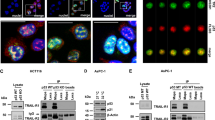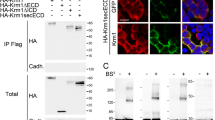Abstract
Death receptor 4 (DR4; also called TRAIL-R1), a member of the tumor necrosis factor receptor superfamily, is a cell surface receptor that triggers the apoptotic machinery upon binding to its ligand tumor necrosis factor-related apoptosis-inducing ligand (TRAIL). Although several chemotherapeutic agents were reported to induce DR4 expression, the mechanism of this effect remains largely unknown. To begin to understand its regulation, we cloned a 1.8 Kb 5′-flanking region of the human DR4 gene and identified several putative binding sites for transcription factors including activator protein 1 (AP-1). Among the three putative AP-1 binding sites, the site located at −350/−344 is functionally active as evidenced by a combination of electrophoretic mobility shift and luciferase reporter assays. The AP-1 activator phorbol 12–myristate 13-acetate (TPA) enhanced the binding of this DR4 AP-1 binding site to protein(s) in a nuclear extract from TPA-treated cells, increased luciferase activity of a reporter construct containing this site and induced DR4 expression at the transcription level. These results indicate that AP-1 regulates DR4 expression via the AP-1 binding site located at −350/−344. AP-1 has been implicated in many critical cellular processes including apoptosis, and is a major target of the c-Jun NH3-terminal kinase signaling pathway that is activated by many anticancer drugs. Therefore, our findings may increase the understanding of the mechanisms underlying AP-1-mediated apoptosis as well as drug-induced apoptosis.
This is a preview of subscription content, access via your institution
Access options
Subscribe to this journal
Receive 50 print issues and online access
$259.00 per year
only $5.18 per issue
Buy this article
- Purchase on Springer Link
- Instant access to full article PDF
Prices may be subject to local taxes which are calculated during checkout





Similar content being viewed by others
References
Ashkenazi A, Dixit VM . 1998 Science 281: 1305–1308
Ashkenazi A, Dixit VM . 1999 Curr. Opin. Cell Biol. 11: 255–260
Ashkenazi A, Pai RC, Fong S, Leung S, Lawrence DA, Marsters SA, Blackie C, Chang L, McMurtrey AE, Hebert A, DeForge L, Koumenis IL, Lewis D, Harris L, Bussiere J, Koeppen H, Shahrokh Z, Schwall RH . 1999 J. Clin. Invest. 104: 155–162
Eichhorst ST, Muller M, Li-Weber M, Schulze-Bergkamen H, Angel P, Krammer PH . 2000 Mol. Cell. Biol. 20: 7826–7837
Fan M, Goodwin ME, Birrer MJ, Chambers TC . 2001 Cancer Res. 61: 4450–4458
Fisher MJ, Virmani AK, Wu L, Aplenc R, Harper JC, Powell SM, Rebbeck TR, Sidransky D, Gazdar AF, El-Deiry WS . 2001 Clin. Cancer Res. 7: 1688–1697
French LE, Tschopp J . 1999 Nat. Med. 5: 146–147
Fricker J . 1999 Mol. Med. Today 5: 374–
Gibson SB, Oyer R, Spalding AC, Anderson SM, Johnson GL . 2000 Mol. Cell. Biol. 20: 205–212
Green DR . 2000 Cell 102: 1–4
Guan B, Yue P, Clayman GL, Sun SY . 2001 J. Cell. Physiol. 188: 98–105
Jo M, Kim TH, Seol DW, Esplen JE, Dorko K, Billiar TR, Strom SC . 2000 Nat. Med. 6: 564–567
Karin M . 1995 J. Biol. Chem. 270: 16483–16486
Kasibhatla S, Brunner T, Genestier L, Echeverri F, Mahboubi A, Green DR . 1998 Mol. Cell. 1: 543–551
Kim K, Fisher MJ, Xu SQ, El-Deiry WS . 2000 Clin. Cancer Res. 6: 335–346
Kolbus A, Herr I, Schreiber M, Debatin KM, Wagner EF, Angel P . 2000 Mol. Cell. Biol. 20: 575–582
Lawrence D, Shahrokh Z, Marsters S, Achilles K, Shih D, Mounho B, Hillan K, Totpal K, DeForge L, Schow P, Hooley J, Sherwood S, Pai R, Leung S, Khan L, Gliniak B, Bussiere J, Smith CA, Strom SS, Kelley S, Fox JA, Thomas D, Ashkenazi A . 2001 Nat. Med. 7: 383–385
Le-Niculescu H, Bonfoco E, Kasuya Y, Claret FX, Green DR, Karin M . 1999 Mol. Cell. Biol. 19: 751–763
Nagane M, Pan G, Weddle JJ, Dixit VM, Cavenee WK, Huang HJ . 2000 Cancer Res. 60: 847–853
Nagane M, Huang HJ, Cavene WK . 2001 Apoptosis 6: 191–197
Osborn MT, Chambers TC . 1996 J. Biol. Chem. 271: 30950–30955
Ozoren N, Fisher MJ, Kim K, Liu CX, Genin A, Shifman Y, Dicker DT, Spinner NB, Lisitsyn NA, El-Deiry WS . 2000 Int. J. Oncol. 16: 917–925
Pan G, O'Rourke K, Chinnaiyan AM, Gentz R, Ebner R, Ni J, Dixit VM . 1997 Science 276: 111–113
Pfahl M, Tzukerman M, Zhang X-K, Lehmann JM, Hermann T, Wills KN, Graupner G . 1990 Methods Enzymol. 189: 256–271
Pitti RM, Marsters SA, Ruppert S, Donahue CJ, Moore A, Ashkenazi A . 1996 J. Biol. Chem. 271: 12687–12690
Pollock R, Treisman R . 1990 Nucleic Acids Res. 18: 6197–6204
Qin JZ, Chaturvedi V, Bonish B, Nickoloff BJ . 2000 Nat. Med. 7: 385–386
Ravi R, Bedi GC, Engstrom LW, Zeng Q, Mookerjee B, Gelinas C, Fuchs EJ, Bedi A . 2001 Nat. Cell Biol. 3: 409–416
Sambrook J, Fritisch EF, Manistis TT . 1989 Molecular Cloning: A Laboratory Manual 2nd edn pp 79–83 Cold Spring Harbor Laboratory, Cold Spring Harbor, NY
Shaulian E, Harin M . 2001 Oncogene 20: 2390–2400
Shin MS, Kim HS, Lee SH, Park WS, Kim SY, Park JY, Lee JH, Lee SK, Lee SN, Jung SS, Han JY, Kim H, Lee JY, Yoo NJ . 2001 Cancer Res. 61: 4942–4946
Sun SY, Yue P, Shroot B, Michel S, Mawson MI, Lamph WW, Heyman RA, Teng M, Chandraratna RAS, Shudo K, Hong WK, Lotan R . 1997 Cancer Res. 57: 4931–4939
Sun SY, Yue P, Wu GS, El-Deiry WS, Shroot B, Hong WK, Lotan R . 1999 Oncogene 18: 2357–2365
Walczak H, Miller RE, Ariail K, Gliniak B, Griffith TS, Kubin M, Chin W, Jones J, Woodward A, Le T, Smith C, Smolak P, Goodwin RG, Rauch CT, Schuh JC, Lynch D . 1999 Nat. Med. 5: 157–163
Wang TH, Wang HS, Ichijo H, Giannakakou P, Foster JS, Fojo T, Wimalasena J . 1998 J. Biol. Chem. 273: 4928–4936
Watabe M, Ito K, Masuda Y, Nakajo S, Nakaya K . 1998 Oncogene 16: 779–787
Wiley SR, Schooley K, Smolak PJ, Din WS, Huang CP, Nicholl JK, Sutherland GR, Smith TD, Rauch C, Smith CA . 1995 Immunity 3: 673–682
Wisdom R . 1999 Exp. Cell Res. 253: 180–185
Xu SQ, El-Deiry WS . 2000 Biochem. Biophys. Res. Commun. 269: 179–190
Acknowledgements
This study was supported in part by the UTMDACC Institutional Research Grant and by a grant from the Prostate Cancer Research Program, The University of Texas, MD Anderson Cancer Center. Sequencing was supported by Cancer Center Core Grant CA16672. We thank Ms Xueyun Chen for her assistance in performing Western blot analysis.
Author information
Authors and Affiliations
Corresponding author
Rights and permissions
About this article
Cite this article
Guan, B., Yue, P., Lotan, R. et al. Evidence that the human death receptor 4 is regulated by activator protein 1. Oncogene 21, 3121–3129 (2002). https://doi.org/10.1038/sj.onc.1205430
Received:
Revised:
Accepted:
Published:
Issue Date:
DOI: https://doi.org/10.1038/sj.onc.1205430
Keywords
This article is cited by
-
DR5 suppression induces sphingosine-1-phosphate-dependent TRAF2 polyubiquitination, leading to activation of JNK/AP-1 and promotion of cancer cell invasion
Cell Communication and Signaling (2017)
-
Oncogenic fusion E2A-HLF sensitizes t(17;19)-positive acute lymphoblastic leukemia to TRAIL-mediated apoptosis by upregulating the expression of death receptors
Leukemia (2012)
-
Resistance to TRAIL and how to surmount it
Immunologic Research (2012)
-
Genome-wide association study identifies two susceptibility loci for exudative age-related macular degeneration in the Japanese population
Nature Genetics (2011)
-
GLI3-dependent repression of DR4 mediates hedgehog antagonism of TRAIL-induced apoptosis
Oncogene (2010)



